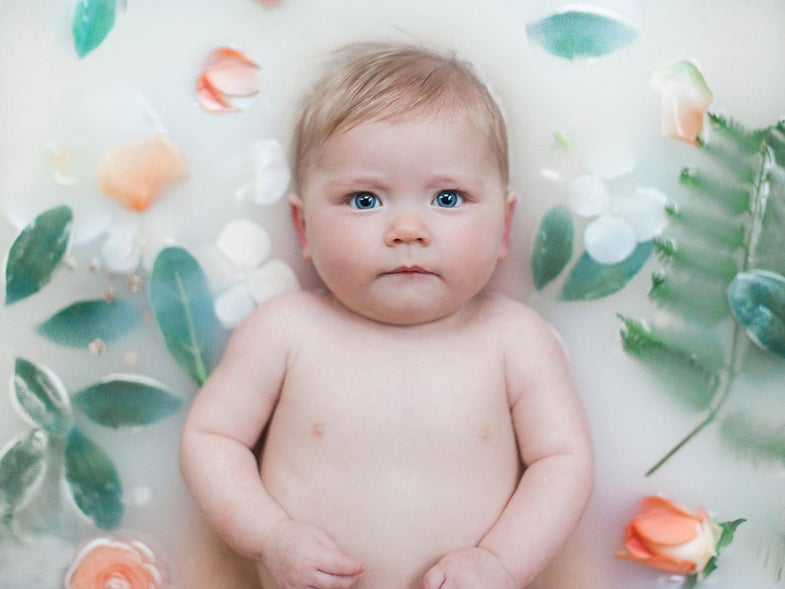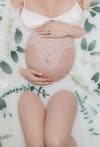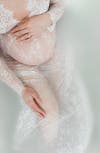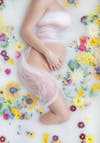How to create surreal milk bath photography
Dive into this popular photographic technique with these tips.

Milk bath photography is wildly popular at the moment, and not just for maternity portraits. You can use the technique with children, babies, mother and baby together, fashion shoots, or even in a boudoir setting. There is something about the white color of the milk that really puts the focus onto your subject. Here are some tips for making the most of your time around the tub.
See more of Tiffany’s work at her website.
Preparing the bathtub for a milk bath photoshoot
There are a few common questions I get about this type of shoot: “How do you make it look like that? Is it real milk? How much?” I have only ever used real milk. Usually I fill the tub to the desired height with water and add in two gallons of whole milk. I sometimes also add some powdered milk to enhance the effect—this could be redundant, but I love opaque, creamy effect that it gives. Using less milk will still create a dreamy mood without obscuring as much of your subject.
Adding props to the milk bath
Most of my clients give me the creative freedom to decide what objects and decorations to add to the bath. A plain milk bath will assure that your subject is the main focal point, but flowers and other organic decorations can give it your photo some texture and contrast.

When designing a milk bath for a client, I pick a color theme and then I start shopping. I use a combination of real flowers and synthetic or silk flowers from the craft store. Trial and error will help you figure out what floats. Real flowers typically float, while synthetic and silk flowers usually sink. My first milk bath I showed up with all the pretty synthetic flowers I could buy, and every single flower sunk to the bottom. We ended up bringing in a bouquet of real flowers and placing the fake flowers on top of those.
If you want the synthetic flowers to float, you can Scotchgard them to make them water-resistant, but some will sink anyway. You can spray them before the shoot, but for best results, you should spray them the night before or even earlier. Take extra care to coat the bottom of the flower, which will actually be resting on the water.
You can also use just greenery in the tub, with no flowers. I am really into bringing nature into the session and I have enjoyed the look immensely.

Managing your props during a milk bath shoot
Keeping the flowers where you want them can be challenging. I don’t Photoshop the scene, so I really spend time working on the placement of the flowers. I have my subjects get in the tub and lay as still as they can—even small movements can shift everything. Then I place the flowers and leaves where I would like them and I start shooting. I often have to stop shooting and move flowers back in place or otherwise readjust the props. This can be much more tricky with little babies who are awake.

Choosing a wardrobe that works well in the milk bath
I love sheer fabric in the water. The way it drapes across the body in the milk creates an ethereal look that I am really drawn to. This can be done with tulle or any other fabric of your choosing. I’ve also done lace tops, lace cover ups, and even simply nude. It really depends on the style you want and on your client’s comfort level with the sheerness and cling of wet fabric.
With nudity, you can use milk or arms to cover across parts that are not appropriate for certain websites. Neither Instagram nor Facebook allow nipples to show, so keep that in mind. I will typically shoot nudity both ways: one with the idea of social sharing in mind, and one without. Private photos, taken only for your client’s personal use, shouldn’t have to be censored.

Posing you subject during a milk bath shoot
I go into the session knowing that set-up and posing will one of the most challenging and time-consuming aspects of the day. I am typically just going for one to three great images to give my clients from this type of session, so it really doesn’t take long to shoot once everything is in place.
My best advice is to work with your subject’s body and try not to copy what you see on Pinterest or elsewhere, because every shape requires its own custom positioning. I don’t like my subjected to be too submerged in the water, but that’s just a preference. Sometimes you have to have subjects hold their head in an uncomfortable position for a few minutes, or you can try placing something under the head to hold it up. I allow the milk to help create a feminine shape on my subject, so playing around with water level once everyone is in position can be really helpful.
I find the most attractive perspective is directly above the subject. I stand on the bathtub and straddle the scene. [Editor’s note: Bathtubs are notoriously slippery things and safety for you and the subject should be the primary concern. If you’re standing on the tub, or a ladder above the tub, always have another person to help spot you and prevent disaster.]

Arranging the lights during a milk bath shoot
I use natural window light if possible for the sessions. Not every bathtub is located next to a window, however, so a big softbox or even flash bounced off of a neutral-colored ceiling can help mimic the effect. I am drawn to flat more than dramatic light for these sessions, but that tends to be more my style and visual brand. I think it’s important to avoid harsh shadows and reflections in the water, which can ruin the aesthetic for me.

Choosing gear for a milk bath shoot
I shoot with a Canon EOS 5D Mark II and my go-to lens is my Canon EF 24–70mm f/2.8L for milk bath sessions. This lens allows me to get that wider shot and tell the full story of the tub when I want to. But, of course, you can use any good camera and lens that gives you a range of wide to moderate telephoto angles of view. I don’t use anything to protect the lens from droplets, since my subjects don’t really splash, but I do wrap my camera strap around my wrist a several times so I don’t drop it in the milk bath.

Editing the photos after the milk bath shoot
I edit exclusively in Adobe Photoshop Lightroom and use Mastin Labs presets for the light and airy look they provide. I apply the preset and adjust each photo accordingly. I will use Lightroom to remove blemishes or anything distracting from the photo. It’s not uncommon to have a light reflection in the water or a rogue leaf that stands out too much and distracts from the subject. I like when the photo appears flat, as if it were a painting, and I keep that as a foundation when editing.
Shooting with a newborn during a milk bath shoot
When deciding to do a milk bath with an infant, I just want to encourage baby safety when photographing in the water. It’s the number-one priority during the shoot! Never leave a baby unattended; make sure the water level is not too high; and check that the water temperature is safe—all the usual rules apply. These sound like common sense, but things can get hectic during a session and you want to avoid risks.

What to do if you don’t have a tub during a milk bath shoot
I have been fortunate enough to shoot in hotel rooms or my clients’ homes with those big bathtubs. Not everyone has access to these, so my suggestion is to make your own: Get a blow-up or plastic kiddie pool and put a white cloth or tarp inside of it to cover the edges. Voilà!—you have yourself a tub! You can’t stand on the rim, but you should be able to straddle it while standing on the ground.